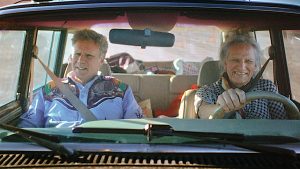
In the very first action set piece of G.I. Joe: The Rise of Cobra, a chopper gets shot out of the sky, crashing in front of a truck carrying heroes that includes Duke (Channing Tatum) and Ripcord (Marlon Wayans). The scene which follow would set the tone for the rest of movie. After that fiery explosion, there is an all-out assault on the soldiers, who do their best to repel the black-clad Cobra troopers. Alas, the heroes’ weapons are no match for the terrorists’ superior tech.
A funny thing, however, is also occurring in this scene—an element which borders on distracting. The camera focuses less on the carnage circling around the heroes and more on the recognizable IP of their vehicles and uniforms. The lens flies past the nose of the Cobra ship attacking Duke and Ripcord in order to instead highlight the high-tech missiles on its side. Each named character gets a hero shot: the Baroness (Sienna Miller) marches toward the camera, flanked by a group of baddies; Snake Eyes (Ray Park) dives into the fray like a silhouetted ninja; and Heavy Duty (Adewale Akinnuoye-Agbaje) fires a really big gun.
Unfortunately, even the movie’s defenders must admit that it’s an ugly spectacle. The gloopy CG takes all the weight out of the exploding vehicles, making them melt toward the ground more than they collapse. It all happens at night, which feels like a concession to the poor effects, but also makes the many black-clad characters feel anonymous.
In this one scene, we see a strange mix of martial arts action in the vein of The Matrix with also the IP-driven considerations that were only becoming more pronounced one year after the first MCU movie, Iron Man. The scene finds G.I. Joe: The Rise of Cobra balancing on a precipice between the traditional action movie introductions of the past and the fan-service blockbusters of the future. It is a turning point in all its garishness.
A Real 2000s Hero
Ten years earlier, G.I. Joe director Stephen Sommers established his blockbuster credentials with The Mummy, which transformed the Universal Monster tale into an old-school adventure in the vein of Indiana Jones. The Mummy was a hit, but it was a movie released a few months earlier that set the tone for the decade to follow. 1999’s The Matrix defined would action cinema would become in the 2000s, making black leather, techno soundtracks, and bullet time effects what ‘roided out heroes and witty one-lines were to the genre in the 1980s.
X-Men, Underworld, Wanted and others tried to replicate the slick sense of cool from The Matrix, while The Bourne Identity, and especially the sequels directed by Paul Greengrass, paved a way for the opposite and opposing reaction. These more stripped down counterintuitive action flicks relied on shaky, handheld cameras which in turn created a sense of realism. But the most important development of the decade turned out to be the blossoming of the superhero genre, especially after Spider-Man in 2002, Batman Begins in 2005, and Iron Man in 2008.
Batman Begins grounded larger-than-life characters in (a type of) reality, providing explanations for all parts of the mythos. Iron Man launched the MCU, rewarding deep fan knowledge with self-aware winks and comic book accurate characters and plots. From this cauldron comes the current cinematic landscape, in which big budget adaptations and nerd culture dominate. As dismissed as it is, G.I. Joe: The Rise of Cobra sits right at the epicenter of this fault line.
Knowing Is Half the Battle
Even though it happens via convoluted plot points, Rise of Cobra is, fundamentally, about the good guy Joes trying to stop the evil terrorists from unleashing chemical weapons. From that simplistic setup, Rise of Cobra combines the various tensions within the action genre. There’s certainly aspects of classic dynamics with Channing Tatum as a standard leading man and Wayans as his motor-mouthed sidekick. Christopher Eccleston chews the scenery as a non-chrome dome Destro, and Joseph Gordon-Levitt gets to be an old school Saturday morning cartoon villain as Cobra Commander. Sommers finds some notes of humor, working in cameos from The Mummy stars Brendan Fraser and Kevin J. O’Connor.
Yet Sommers struggles a bit more when he leans into Matrix territory. Rise of Cobra eschews the colorful costumes of the ’80s cartoon and toy line, with only Storm Shadow and Snake Eyes matching their predecessors. The other characters all wear black leather, complete with augmented power suits. Sommers has fun making the Joes into comic book heroes as they bound across the battlefield, but there’s no sense of slickness in these scenes.
What really stands out though is the way that Rise of Cobra integrates the trends of the day while looking forward at what’s next in the genre. Screenwriters Stuart Beattie, David Elliot, and Paul Lovett (with a story credit to Beattie, Sommers, and Michael B. Gordon) try to emulate the Batman Begins approach by connecting all of the characters before they embraced their iconography, and then gave them “real” human histories (or at least the CW equivalent). In this telling, Duke was once engaged to Baroness, back when she was just called Ana Lewis. Before he was Cobra Commander, Rex Lewis was Ana’s brother and Duke’s best friend, who turned into an evil scientist after a mission gone wrong.
Even though it just came out a year earlier, Iron Man also looms large over Rise of Cobra. G.I. Joe is, fundamentally, a toy commercial, made to sell action figures of colorful characters with flashy names. Sommers works big character moments into his movie, complete with hero shots in the aforementioned opening battle. For instance, that scene seems to pause momentarily for each named character to stand in the frame and look cool. Scarlett (Rachel Nichols) loads her crossbow and turns to the camera with a snap. Breaker (Saïd Taghmaoui) gears up and looks off in the middle distance with determination. Snake Eyes dives out of a chopper with his sword drawn, setting up his eventual face off with his arch-enemy Storm Shadow (Lee Byung-hun).
None of these hero moments make much sense story-wise, and they clash against the soapy drama and Sommers’s solid action chops. But they unintentionally predict the future of big budget filmmaking, as studios spend the 2010s attempting to replicate the MCU formula.
Fighting to Save Tomorrow
For all of its shortcomings, G.I. Joe: The Rise of Cobra has its charms. Sommers is still enough of a solid action director to make the movie a fun watch, especially with such a game cast. But 15 years later, The Rise of Cobra functions best as a snapshot of its era, a shifting landscape where recognizable character takes precedence over basic storytelling and cool set pieces. It contains remnants of action filmmaking that too many blockbusters have forgotten.
Throughout Rise of Cobra, Sommers shows off skills that modern action filmmakers should know. Because, of course, knowing is half the battle.
The post G.I. Joe: The Rise of Cobra Was a Turning Point in Blockbuster Movies appeared first on Den of Geek.




